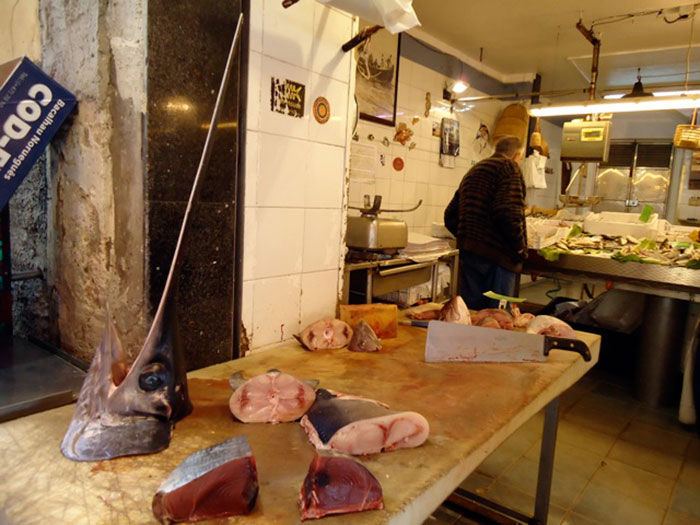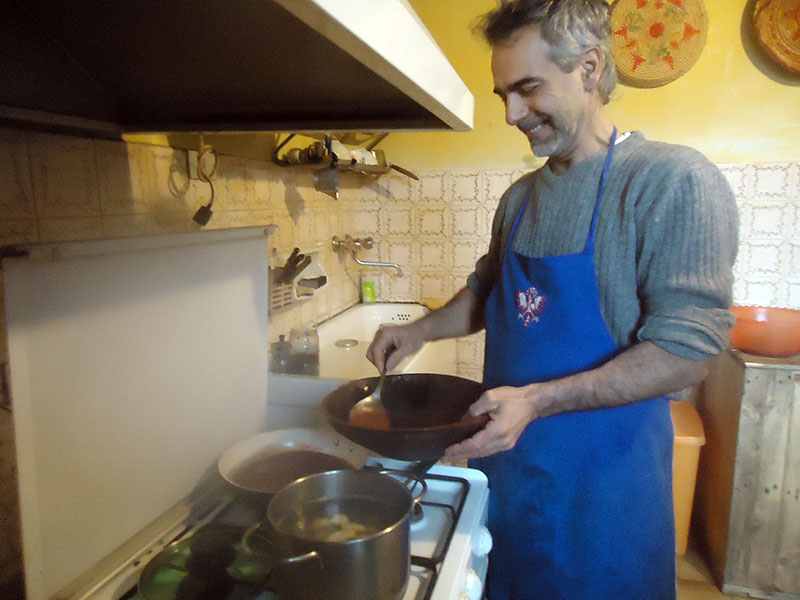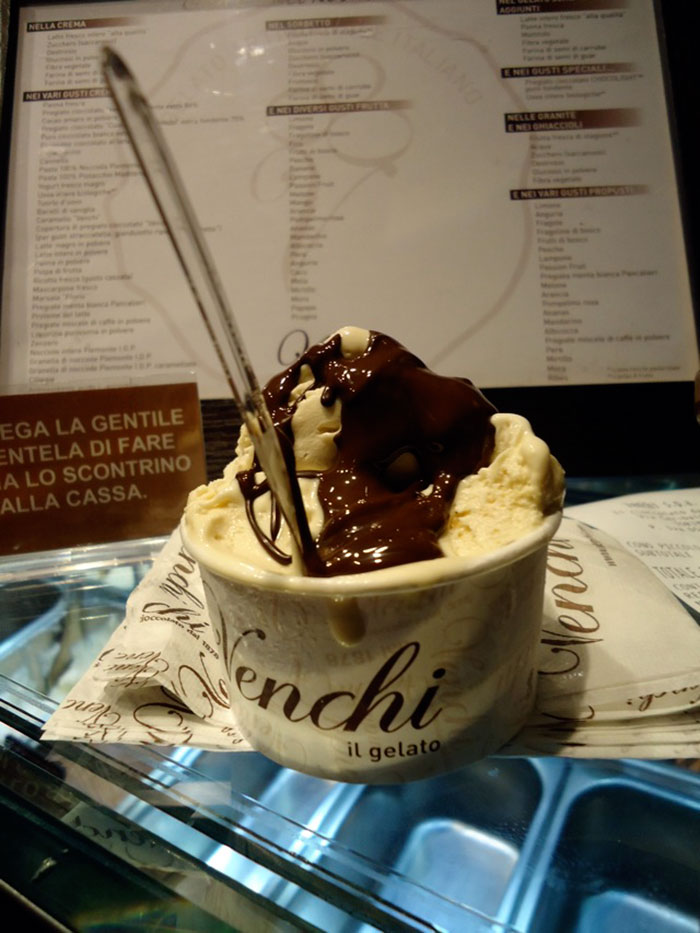Italia! The land of pizza napoletana, lasagna, Parmigiano-Reggiano, proscuitto, Nebbiolo, gelato, cannolo, limoncello and some of the world’s best espresso.
Vagabondish is reader-supported. When you buy through links on our site, we may earn a small affiliate commission. Read our disclosure.
Visiting such an epicurean all-star can be daunting for a dedicated diner. With so many essentials to try and tourist traps to fall into, how do you optimize your epicurean exploits? First, put down the Ramen. Then, follow these twelve tips to make the most of every bite without breaking the bank.
#1: To Market, to Market

Fresh Meat, Italy © Jaclyn Einis
Whether you’re in a village, city center or urban outskirt, it’s hard not to stumble upon a market in Italy. There’s Firenze’s Mercato Centrale San Lorenzo, Venezia’s Mercato Rialto, Siracusa’s Antico Mercato and Modena’s Mercato Coperto, to name a few.
Depending on the size of the market, you’ll find local produce, cheese, bread, meat, seafood, olive oil, baked goods, wine and even homemade liqueur. Farmer’s markets are the ultimate opportunity to try something new and hyper-local. Chances are, you’ll find a few vegetables that are foreign to you (like the geometric wonder that is broccoli romano) and cheeses unique to a single farm (a particular goat-cow’s milk blend from Genoa still frequents my daydreams).
Some of my favorite and cheapest meals in Italy were impromptu picnics; my market buys spread out on a rock by the sea, prime people-watching bench, cathedral steps or random sidewalk. The consummate sampler, I love to buy just a bit of many different items ”¦ and free tastes from amiable vendors never hurt.
#2: When in Rome …
”¦ eat like a Roman! Trying a region’s signature dish is a powerful way to connect to local culture and history. You can find out which dishes an area is known for by common sense (pesto Genovese, ragù alla Bolognese and proscuitto di Parma, for example), asking locals or doing your homework, be it in-depth research, or a bit of BootsnAll, No Reservations and NYT Travel Section sleuthing.
They’re often cheap, like arancini (fried rice balls) in Sicily, pizza margherita in Naples, torta di ceci or “cinque cinque” (think wood-fired chickpea pancake) in Livorno, baccalà (salt cod) Venice or carciofo alla giudia (fried artichoke dish known as “Jewish Artichoke”) in Rome and foccacia (the famed olive oil infused bread) in Genoa – and most always worth the hype.
#3: Aperitivo
Sometimes it’s a cheap glass of wine and a bottomless plate of cold pizza and potato chips; sometimes, it’s a pricier glass of wine or Spritz (a popular Italian cocktail made with Aperol and Prosecco) and a buffet of mini sandwiches, hot ziti and bruschetta.
At a swanky Milano bar with a view of the Duomo, my expensive wine came with a waiter-served platter featuring chicken satay, shrimp, noodle salad and a spring roll. Aperitivo is Italy’s Happy Hour, when bars serve free pre-dinner snacks to go with a slightly priced-up pre-dinner drink. These snacks can tide you over while waiting for a late dinner, or turn into a full-on budget meal. It may not be the most memorable meal you have in Italy, but if you ask around for a good aperitivo you’re bound to find yourself a tasty dinner, gratis.
#4: Dine in

Home Cooked Meal, Italy © Jaclyn Einis
When it comes to authentic Italian experiences, it doesn’t get much better than a homecooked meal. Family recipes, second helpings, good company and market-value wine are just a few of the benefits of eating in an Italian home.
Between WWOOFing (Worldwide Opportunities on Organic Farms) and Couchsurfing, I enjoyed most of my meals “at home,” lingering for hours over bottles of wine (to be followed by grappa and espresso) during relaxed lunches and dinners. WWOOFing, or any sort of work exchange or homestay program, Couchsurfing and simply making friends are all solid paths to homemade feasts.
If you’re as lucky as I was, you’ll be privy to a few nonna-cooked meals. Even my most casual of Couchsurfing dinners still consisted of impressive pasta and a peek into the customs of young Italians (even college students are more likely than most Americans to use tablecloths, for instance).
If you’re just passing through for a few days, check out the Home Food project. The Home Food project will hook you up with hosts (Home Food affectionately refers to their “ladies of the house” as “Cesarine”) to help you experience Italian hospitality and a multi-course meal particular to a region’s products and traditions (typically 34-50 Euros per guest).
#5: Play Sous-Chef
If you’re in an Italian home, take advantage of your resources! Just because you can’t afford to go to a fancy cooking school vacation doesn’t mean you can’t take a trip to the market and learn a few new recipes while in Italy.
Make gnocchi or tiramisu from scratch; learn the trick to your host’s favorite risotto; help create one of their favorite family recipes. Assuming these recipes aren’t secret, remember to write them down so you can recreate them at home. With different ingredients, down to the flour and water, and appliances, you won’t be able to replicate the exact dish you helped make in Italy, but I bet your friends will still be impressed!
#6: Eschew Menus
Go for a counter-order bistro where everything’s a daily special so there’s no menu needed. Try your choice of antipasti in a hidden corner dive like Siena’s cleverly-named 12-seat Osteria il Grattacielo (“Skyscraper Tavern”), or a few of Venice’s famous cicchetti, bite-sized snacks or side dishes served in bà cari (Venetian osterie or wine bars). Picking your platter is a fun way to get market-fresh food and great value in a lively, local atmosphere.
#7: Go Back
If you have the luxury to be in one place for a while, don’t deny yourself a return visit to your favorite café or restaurant, be it for a dish you really loved or to try the ones you missed the first time around.
There’s no better way to make a foreign place feel like home than a personal greeting from a proprietor who’s excited to see you and exchanging a knowing smile with the regulars. If it’s a small shop, don’t be surprised if your second or third visit brings improved service, a special recommendation or, if they’re really excited to see you, a little something on the house.
#8: Go to the Source

Grapes on the Vine, Italy © Jaclyn Einis
Tasting something freshly picked, pressed, bottled, juiced ”¦ is a sensation every food and wine lover should experience. Take a trip to the vineyard, the grove, the orchard, the garden, the forest or the farm. Meet the winemaker, or better yet, pick the grapes.
Whatever you’re eating or drinking will taste better when you know the people, process and story behind the product; more so if you’ve also had a chance to be part of that process.
Your pleasure will be even greater if you also see that what you’re consuming — be it wine, strawberries, tomatoes or a pig roast — was produced organically and ethically. WWOOFing is a great way to do this, but so is a meal at an agritourism or a tasting at a winery.
#9: Brave the Bakery
Pasticcerias’ floor-to-ceiling windows present enough fascinating candies and baked goods to keep the sweetest of teeth eternally entertained. Indulge in a bagful of random cookies and pastries. Make sure to try local (like sfogliatelle – a many-pleated, ricotta-filled pastry — in Naples and Salerno, marzipan — sugary almond paste, often formed into faux fruit — in Sicily, panforte — a dense, chewy fruit and nut cake — in Siena and Gianduiotto — chocolate made from a hazelnut, cocoa, sugar paste — in Turin), seasonal (like icy granita in the summer and marrons glacés — glazed, candied chestnuts — in late fall and winter) and holiday-specific specialties (like pannetone dessert bread around Christmas and New Years and cuccia, a sweet pudding-like wheat berry dish consumed in Palermo to honor Saint Lucia on December 13).
As for you Splenda-rrific sugar haters, remember: you’re in Italy! Challenge yourself to count discoveries, not calories. While you’re feeling bold, ask the baker about the confections you’re curious about. Many Italians speak English, but it’s helpful to learn a bit of Italian and/or carry a dictionary, especially in the south where English is less common.
And remember, no matter how hard you fall for a pastry, you’re still likely to forget its name. Take notes or snap display case close-ups to help you remember what you eat.
#10: Ask a Local
Whether it’s your host, new friend, friend’s friend or a random cashier, this is the best way to discover the neighborhood’s favorite hole-in-the-wall spots you’d have otherwise walked right by. Plus, you never know when “Giovanni sent me” will get you special treatment.
#11: Go with a Local
This is another path to discovering a local’s favorite restaurant, without the risk of getting lost along the way. Aside from the simple joy of sharing a meal with a new friend, it’s a great way to find out what to order (sometimes the best order is off-the-menu) and avoid bad vibes from any tourist-hating waiters (don’t worry; there aren’t a lot of them).
If your server speaks no English and you speak no Italian, your amico can help translate your charming questions and compliments to the chef.
#12: Just Say “Si!” to Gelato

Gelato (closeup), Italy © Jaclyn Einis
When it comes to gelato consumption, think: “artisanal” and “everywhere.” Quality chains like Grom (if you don’t live close to the New York City outpost) and Piemonte-based Venchi are acceptable, but the local boutique gelaterias are musts.
Being a prolific gelato consumer will give you the leeway to see how hazelnut and pistachio vary from Florence to Agrigento; to try more obscure and seasonal flavors like marron glacé, zabaglione, honey and saltines or even focaccia-cappuccino. Every city and shop has its own special touch, like Palermo’s “gelato con brioche” overflowing ice cream sandwich.
Buon Appetito!


